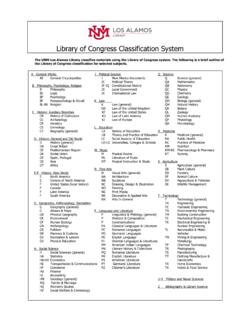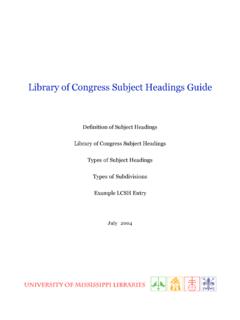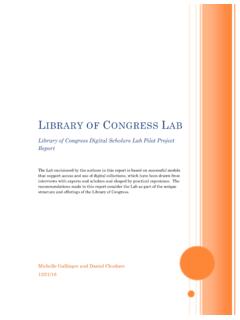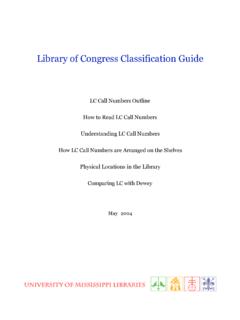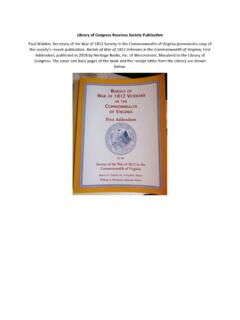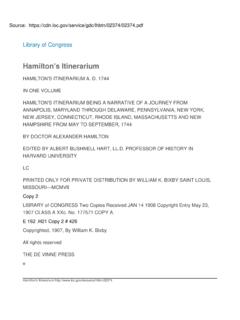Transcription of Library of Congress Cataloging-in-Publication Data
1 Copyright 2014, by Salem Press, A Division of EBSCO Information Services, Inc. All rights reserved. No part of this work may be used or reproduced in any manner whatsoever or transmitted in any form or by any means, electronic or mechanical, including photocopy, recording, or any information storage and retrieval system, without written permission from the copyright owner. For permissions requests, contact For information, contact Grey House Publishing/Salem Press, 4919 Route 22, PO Box 56, Amenia, NY 12501. The paper used in these volumes conforms to the American National Standard for Permanence of Paper for Printed Library Materials, (R1997). Library of Congress Cataloging-in-Publication DataAncient creatures / edited by Spencer G. Lucas, -- [First edition]. pages : illustrations, maps ; cm Includes bibliographical references and index. ISBN: 978-1-61925-687-3 1. Dinosaurs. I. Lucas, Spencer A53 IN THE UNITED STATES OF AMERICAPage 3 DIMETRODON(di-MEH-tro-don) Two Measures of Teeth FOSSIL LOCATIONE astern Europe (Russia); North America (Oklahoma, Texas)WEIGHTL ength m (8-10 ft)Height 1 m ( ft)150-250 kg(330-550 lbs)SIZELIFESPANDIETC arnivoreUnknownTriassic Period251 - 201 million years agoJurassic Period201 - 145 million years agoCretaceous Period145 - 66 million years agoTIME PERIODINTRODUCTIOND imetrodon is perhaps the most recognizable member of the synapsid reptiles, which is believed to be the hereditary line that eventually gave rise to the mammals.
2 Synapsids are characterized by the presence of temporal openings in the skull below and posterior to each eye socket. These openings both decreased the effective mass of the skull and accommodated the attachment of the jaw muscles to produce stronger jaws. Dimetrodon itself is most recognizable by the large sail-like dorsal n extending like a fan from the back of the neck to a point on the tail behind the lower Dimetrodon has been made popularly familiar as a dinosaur, often as the rst creature described in children s books about dinosaurs, it is not a member of the dinosaur family at all. Dimetrodon actually lived in the Early Permianperiod, and so, predates the dinosaurs by many millions of years. It shares the feature of a prominent dorsal sail, with its contemporary pelycosaur, Edaphosaurus. Two Cretaceous dinosaurs, Spinosaurus and Ouranosaurus, also featured a pronounced dorsal structure reminiscent of Dimetrodon s sail, and for many years, paleontologists believed that they sported a sail structure similar to Dimetrodon.
3 More recent research of these Cretaceous dorsal structures indicates that these dorsal structures were slightly different and probably looked more like a hump than a widely separated geographic regions in which Dimetrodon fossils have been found lend support to the theory that all of the planet s land masses were once part of the supercontinent known as Pangaea. Tectonic activity occurring over millions of years slowly pulled this giant land mass in different directions, fracturing and refracturing it into the various segments that have formed the continental masses that exist today. The effect can be seen on a small scale in the way the solid crust that forms on molten lava fractures and moves about according to the motions of the underlying uid material. The various locations in which the fossils of animals such as Dimetrodon have been found are therefore Dimetrodon Permian Period299 - 285 million years AnimaliaPhylum.
4 ChordataSuper Class .. TetrapodaOrder .. Pelycosauria Suborder .. DimetrodonSpecies ..grandisCLASSIFICATIONPage 4 Ancient Creatures 4 DimetrodonDimetrodon(di-MEH-tro-don) (di-MEH-tro-don) Two Measures of Teeth Two Measures of Teeth believed to have been part of the same geographical region of Pangaea when those animals were alive some 290 million years Dimetrodon is a pelycosaur, of the Sphenacodontidae family, which lived in the Permian period of geological time, between 251 and 299 million years ago. The popular association of Dimetrodon with the dinosaurs is entirely erroneous, however, because true dinosaurs are not recognized from the fossil record until about 50 million years after the period in which Dimetrodon and its relatives ourished. The original classi cation of Dimetrodon as a dinosaur was based on a stereotypical popular image of dinosaurs as oversized primitive reptiles like gigantic lizards and cation of plants and animals, including dinosaurs, is generally made according to the system devised by Carl Linnaeus, a Swedish naturalist who lived in the early Dimetrodon5 Dimetrodon 5eighteenth century.
5 In 1735, Linnaeus published a scienti c book called System of Nature, in which he classi ed plants and animals by class, order, genus, and species. Each step in the classi cation identi ed a group of decreasing diversity or variation, with the species being the most speci c identi er of any living organism. Linnaeus work marked a revolution in the way in which scientists viewed the living beings of the since Linnaeus time have expanded his system of classi cation by the introduction of cladistics. Cladistic classi cation is based on the concept of evolution and ties different groups of animals together through common ancestral forms. Thus, the broad classi cation of the Chordata includes all animals with a spinal structure or spinal chord, and the narrower classi cation of the Synapsida includes all animals with spinal chords and the synapsid skull structure.
6 This path is typically illustrated with the use of a cladogram, which is essentially just the family tree diagram for a creature. Such cladistic analysis is amenable to being adjusted according to new information that becomes available and is also conducive to the development of new theories and the re nement of older ones. Dimetrodon is classed as a member of the Sphenacodontidae according to the structure of its head and dentition. The Sphenacodontidae are characterized by relatively long and narrow, but massive, jaws armed with large canine teeth and knife-like incisors at the front of the jaw, and smaller shearing teeth along the Dimetrodon was a carnivorous quadruped that resembled an oversized lizard. Adult Dimetrodons grew to a length of 3 meters (10 ft) and body height of up to 1 meter (3 ft). Dimetrodon s most prominent feature was a large semi-circular, n-shaped structure that extended from the base of the skull to the base of the tail just behind the rear hips.
7 The n was formed by the elongated spines of the vertebrae and was believed to have been covered by a more or less eshy membrane of skin that was richly supplied with blood vessels. This sail added another 1 meter (3 ft) to the overall height of the creature. Microscopic examination of the internal structure of fossilized Dimetrodon bones reveals a lack of blood vessels consistent with the cold-blooded or ectothermic nature of name Dimetrodon is a combination word meaning two measures (or forms) teeth, due to the nature of its dental equipment. The blunt, square-shaped mouth of Dimetrodon was equipped with both large canine teeth at the front of the mouth and well-developed shearing teeth along the sides of the jaws. The large canines enabled Dimetrodon to x its prey with a secure grip and to deliver a killing bite, while the shearing teeth enabled it to bite through and shear off mouth-sized chunks of esh from its prey.
8 The synapsid structure of Dimetrodon s skull accommodated the extra-large muscles that powered the biting force of the jaws, which is perhaps the main reason it was the top predator of its actual structure and function of Dimetrodon s sail is the subject of some controversy. Because Dimetrodon was a reptile, and not a dinosaur, it is generally accepted among paleontologists that the sail served as a thermoregulatory structure that enabled Dimetrodon to maintain a fairly constant body temperature. The structure of the spinal vertebrae does not indicate that the sail could be folded down to the body, but that it was held erect at all times. Thus, by turning so that sunlight could impinge directly on the skin of the sail, Dimetrodon would have been able to harvest heat from the sun to raise its body temperature when needed.
9 Alternatively, ushing the sail with blood when overheating would have enabled Dimetrodon to eliminate excess heat by transferring it to any cooling wind that happened to be is also possible that Dimetrodon s sail was used to communicate with other Dimetrodons as part of the mating process or as a threat display to exert dominance over rival Dimetrodons and other creatures. This may never be known for certain, as the dorsal sail of the Dimetrodon is [Note: Human height is m (6 ft)]HEIGHT (M)LENGTH (M)MEASUREMENT CHARTThe average Dimetrodon had a length of m (8-10 ft) and a height of 1 m ( ft).210 0 1 2 3 4 5 6 | | | | | | | | | | | | | | | | 6 Ancient Creatures presumably found on fossils of both males and females of the Dimetrodon had a massively built skull that accounted for about 14 percent of its overall length.
10 The skull exhibits a large nasal structure indicative of an acute sense of smell. The brain case itself, however, is very low and sloping, especially over the eyes. This suggests a small brain with a disproportionately large frontal lobe for the sense of intelligence is estimated using a measurement called the encephalization quotient (EQ). It essentially compares the size of an animal s brain to the average brain size of animals having similar body mass. It is presumed that the level of intelligence corresponds to the EQ, at least in general terms, such that the higher the EQ, the higher the animal s level of intelligence. Conversely, the lower is the EQ, the lower is the intelligence of the EQ value for Dimetrodon has been estimated. It may, however, have been on a par with that of modern crocodiles and AND POPULATIONIt can be argued that Dimetrodon was very successful, surviving as a species for as much as 20 million years.

